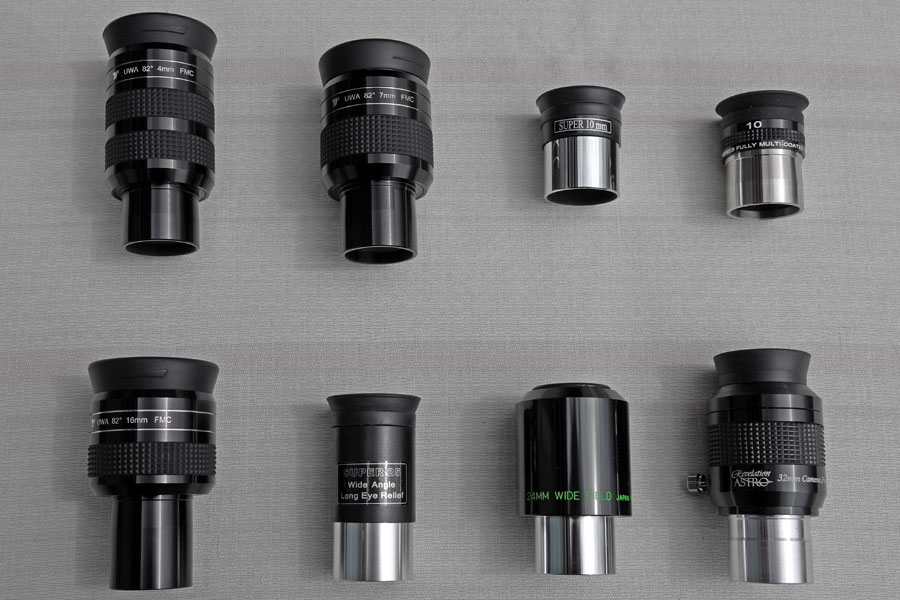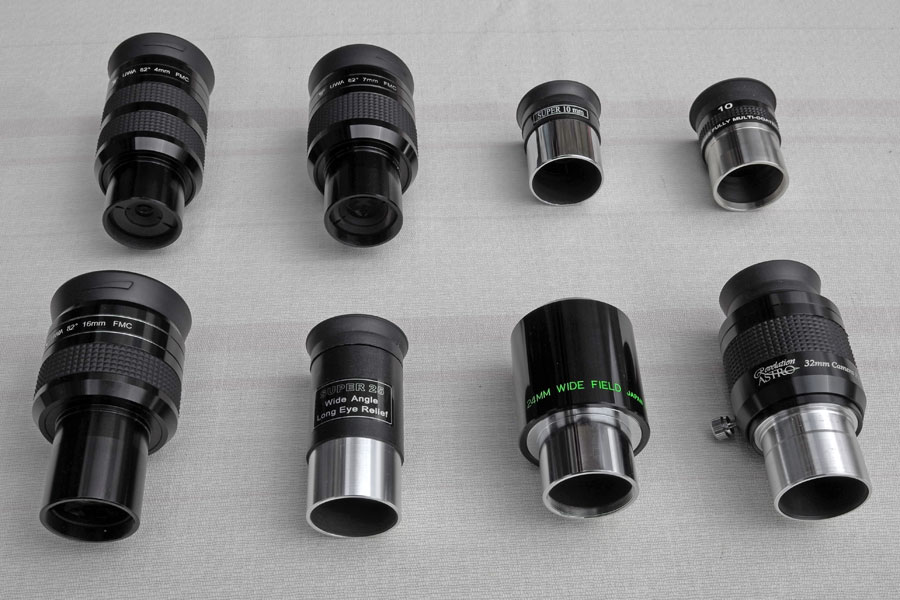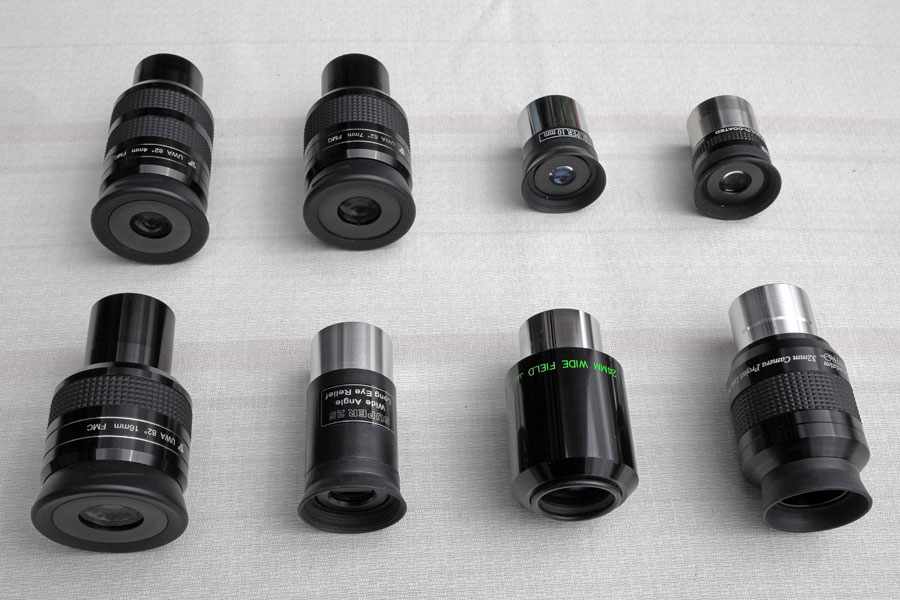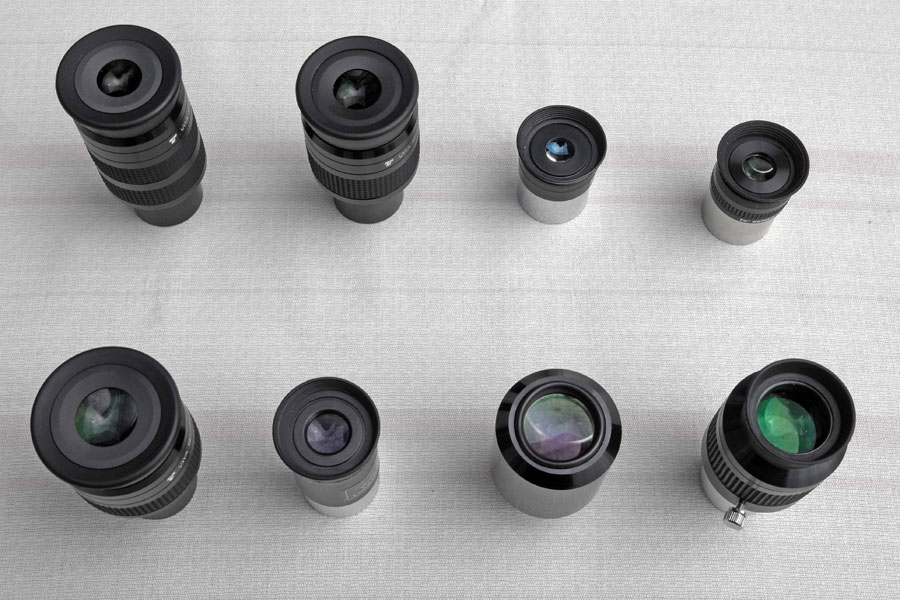Some Information About Eyepieces
What is an Eyepiece? | Eyepiece Types | Visual Power (Magnification) for Different Focal Lengths of Eyepieces | Field of View | Exit Pupil | References
On this page, I present some elementary information about eyepieces, particularly about different types of eyepieces.
Note: For definitions in a small glossary, see page Quick & Dirty Astronomy Glossary.
What is an Eyepiece?
An eyepiece, or ocular lens (from latin oculus = eye), is a type of lens that is attached to a variety of optical devices such as telescopes and microscopes. It is so named because it is usually the lens that is closest to the eye when someone looks through the device. An eyepiece consists of several "lens elements" in a housing, with a "barrel" on one end. The objective lens or mirror collects light and brings it to focus creating an image. The eyepiece is placed near the focal point of the objective to magnify this image. The amount of magnification depends on the focal length of the eyepiece. Eyepieces also offer varying fields of view, and differing degrees of eye relief for the person who looks through them. (From: Eyepiece – Wikipedia and Okular – Wikipedia)
As examples of eyepieces, I present my current ones (as of May 2017; the crosshair and the 28 mm eyepiece for 2" are missing):
 |
 |
|
 |
 |
Photos: Top row (from left to right): 4 mm and 7 mm UWA, 10 mm Sky-Watcher eyepiece, 10 mm Explore Scientific eyepiece; bottom row (from left to right): 16 mm UWA, 25 mm Sky-Watcher eyepiece, 24 mm TeleVue eyepiece, 32 mm Plössl eyepiece
The 12.5 mm crosshair Plössl eyepiece is not shown, as well as the 28 mm eyepiece for my 6" Newton tube (2"). In the meantime, my eyepiece collection has changed a bit (see page Data of All My Telescopes and Eyepieces).
Eyepiece Types
Note: The descriptions on this page were taken from page "Eyepiece" in the English version of Wikipedia. The descriptions therefore differ in part considerably from those of the German version of this page, where the descriptions were taken from page "Okular" in the German version of Wikipedia.
| Name | Description* | # of Lenses/ Field of View |
Characteristics, Improvements, Remarks* |
| Galilean Eyepiece | The simple negative lens placed before the focus of the objective has the advantage of presenting an erect image but with limited field of view better suited to low magnification. It is suspected this type of lens was used in some of the first refracting telescopes that appeared in the Netherlands in about 1608. It was also used in Galileo Galilei's 1609 telescope design which gave this type of eyepiece arrangement the name "Galilean". | 1 | This type of eyepiece is still used in very cheap telescopes, binoculars and in opera glasses. |
| Convex Lens, Kepler Eyepiece | A simple convex lens placed after the focus of the objective lens presents the viewer with a magnified inverted image. This configuration may have been used in the first refracting telescopes from the Netherlands and was proposed as a way to have a much wider field of view and higher magnification in telescopes in Johannes Kepler's 1611 book Dioptrice. | 1 | Since the lens is placed after the focal plane of the objective it also allowed for use of a micrometer at the focal plane (used for determining the angular size and/or distance between objects observed). |
| Huygens Eyepiece | Huygens eyepieces consist of two plano-convex lenses with the plane sides towards the eye separated by an air gap. The lenses are called the eye lens and the field lens. The focal plane is located between the two lenses. It was invented by Christiaan Huygens in the late 1660s and was the first compound (multi-lens) eyepiece. Huygens discovered that two air spaced lenses can be used to make an eyepiece with zero transverse chromatic aberration. | 2 / 30°? |
These eyepieces work well with the very long focal length telescopes
(in Huygens day they were used with single element long focal length
non-achromatic refracting telescopes, including very long focal length
aerial telescopes). This optical design is now considered obsolete since
with today's shorter focal length telescopes the eyepiece suffers from
short eye relief, high image distortion, chromatic aberration, and a
very narrow apparent field of view.
Since these eyepieces are cheap to make they can often be found on inexpensive telescopes and microscopes |
| Mittenzwey Eyepiece | Developed by Moritz Mittenzwey (Zwickau) in the 18. century for telescopes and microscopes. It resembles the Huygens eyepiece, but has, instead of the plano lenses, two concave-convex lenses at a distance of their average focal length. The two concave lens planes point back, that is towards the eye. Between the field lens and the eye lens there is the focal plane with a diaphragm that reduces disturbing reflexes caused by the walls of the eyepiece barrel. | 2 / up to 50° |
Has two concave-convex lenses instead of the plano lenses at a distance
of their average focal length. This increases the field of view up to
50°. This was the first eyepiece with a larger field of view.
The Mittenzwey variant of the Huygens eyepiece is considered obsolete today, because the eye has to be held closely to the eyepiece. One other hand, it can be produced economically and is therefore still used for budget telescoped and microscopes. |
| Ramsden Eyepiece | The Ramsden eyepiece comprises two plano-convex lenses of the same glass
and similar focal lengths, placed less than one eye-lens focal length apart,
a design created by astronomical and scientific instrument maker Jesse
Ramsden in 1782. The lens separation varies between different designs,
but is typically somewhere between 7/10 and 7/8 of the focal length of
the eye-lens, the choice being a trade off between residual transverse
chromatic aberration (at low values) and at high values running the risk
of the field lens touching the focal plane when used by an observer who
works with a close virtual image such as a myopic observer, or a young
person whose accommodation is able to cope with a close virtual image.
A separation of exactly one focal length is also inadvisable since it renders the dust on the field lens disturbingly in focus. The two curved surfaces face inwards. The focal plane is thus located outside of the eyepiece and is hence accessible as a location where a graticule, or micrometer crosshairs may be placed. |
2 / 30°? |
Because a separation of exactly one focal length would be required
to correct transverse chromatic aberration, it is not possible to correct
the Ramsden design completely for transverse chromatic aberration. The
design is slightly better than Huygens but still not up to today's
standards.
It remains highly suitable for use with instruments operating using near-monochromatic light sources e.g. polarimeters. |
| Kellner Eyepiece ("Achromat") | In a Kellner eyepiece an achromatic doublet is used in place of the simple plano-convex eye lens in the Ramsden design to correct the residual transverse chromatic aberration. Carl Kellner designed this first modern achromatic eyepiece in 1849, also called an "achromatized Ramsden". Kellner eyepieces are a 3-lens design. | 3 / 40°...42° |
Kellner eyepieces are inexpensive and have fairly good image from low to medium power and are far superior to Huygenian or Ramsden design. The eye relief is better than the Huygenian and worse than the Ramsden eyepieces. The biggest problem of Kellner eyepieces was internal reflections. Today's anti-reflection coatings make these usable, economical choices for small to medium aperture telescopes with focal ratio f/6 or longer. The typical apparent field of view is 40–50°. |
| Monocentric Eyepiece | A Monocentric is an achromatic triplet lens with two pieces of crown glass cemented on both sides of a flint glass element. The elements are thick, strongly curved, and their surfaces have a common center giving it the name "monocentric". It was invented by Hugo Adolf Steinheil around 1883. | 3 / 28° |
This design, like the solid eyepiece designs of Robert Tolles, Charles S. Hastings, and E. Wilfred Taylor, is free from ghost reflections and gives a bright contrasty image, a desirable feature when it was invented (before anti-reflective coatings). It has a narrow field of view of around 25° and is a favorite amongst planetary observers. |
| Orthoscopic Eyepiece after Ernst Abbe | The 4-element orthoscopic eyepiece consists of a plano-convex singlet eye lens and a cemented convex-convex triplet field lens achromatic field lens. This gives the eyepiece a nearly perfect image quality and good eye relief, but a narrow apparent field of view - about 40°–45°. It was invented by Ernst Abbe in 1880. It is called "orthoscopic" or "orthographic" because of its low degree of distortion and is also sometimes called an "ortho" or "Abbe". |
4 / 40° |
Until the advent of multicoatings and the popularity of the Plössl, orthoscopics were the most popular design for telescope eyepieces. Even today these eyepieces are considered good eyepieces for planetary and lunar viewing. Due to their low degree of distortion and the corresponding globe effect, they are less suitable for applications which require an excessive panning of the instrument. |
| Orthoscopic Eyepiece after Albert König | The König eyepiece has a concave-convex positive doublet and a plano-convex singlet. The strongly convex surfaces of the doublet and singlet face and (nearly) touch each other. The doublet has its concave surface facing the light source and the singlet has its almost flat (slightly convex) surface facing the eye. It was designed in 1915 by German optician Albert König (1871−1946) as a simplified Abbe version. The design allows for high magnification with remarkably high eye relief - the highest eye relief proportional to focal length of any design before the Nagler in 1979. The field of view of about 55° makes its performance similar to the Plössl, with the advantage of requiring one less lens. | 3 / 40°, 55°? |
Modern versions of Königs can use improved glass, or add more lenses, grouped into various combinations of doublets and singlets. The most typical adaptation is to add a positive, concave-convex simple lens before the doublet, with the concave face towards the light source and the convex surface facing the doublet. Modern improvements typically have fields of view of 60°−70°. |
| Plössl Eyepiece, Symmetrical Eyepiece | The Plössl is an eyepiece usually consisting of two sets of doublets, designed by Georg Simon Plössl in 1860. Since the two doublets can be identical this design is sometimes called a symmetrical eyepiece. The compound Plössl lens provides a large 50° or more apparent field of view, along with relatively large FOV. This makes this eyepiece ideal for a variety of observational purposes including deep-sky and planetary viewing. The chief disadvantage of the Plössl optical design is short eye relief compared to an orthoscopic since the Plössl eye relief is restricted to about 70–80% of focal length. The short eye relief is more critical in short focal lengths below about 10 mm, when viewing can become uncomfortable especially for people wearing glasses. | 4 / 50°...52° |
The Plössl eyepiece was an obscure design until the 1980s when
astronomical equipment manufacturers started selling redesigned versions
of it. Today it is a very popular design on the amateur astronomical
market, where the name Plössl covers a range of eyepieces with
at least four optical elements.
This eyepiece is one of the more expensive to manufacture because of the quality of glass, and the need for well matched convex and concave lenses to prevent internal reflections. Due to this fact, the quality of different Plössl eyepieces varies. There are notable differences between cheap Plössls with simplest anti-reflection coatings and well made ones. |
| Erfle Eyepiece, Super Plössl Eypiece | An Erfle is a 5-element eyepiece consisting of two achromatic lenses with extra lenses in between. They were invented during the first world war for military purposes, described in US patent by Heinrich Erfle and are a logical extension to wider fields of four element eyepieces such as Plössls. | 5 / 60° (Super Plössl), up to 68° |
Erfle eyepieces are designed to have wide field of view (about 60 degrees), but they are unusable at high powers because they suffer from astigmatism and ghost images. However, with lens coatings at low powers (focal lengths of 20 mm and up) they are acceptable, and at 40 mm they can be excellent. Erfles are very popular because they have large eye lenses, good eye relief and can be very comfortable to use. |
| Nagler Eyepiece, Ethos Eyepiece, ... | Invented by Albert Nagler and patented in 1979, the Nagler eyepiece is a design optimized for astronomical telescopes to give an ultra-wide field of view (82°) that has good correction for astigmatism and other aberrations. Introduced in 2007, the Ethos is an enhanced ultra-wide field design developed principally by Paul Dellechiaie under Albert Nagler's guidance at Tele Vue Optics and claims a 100–110° AFOV. This is achieved using exotic high-index glass and up to eight optical elements in four or five groups; there are five similar designs called the Nagler, Nagler type 2, Nagler type 4, Nagler type 5, and Nagler type 6. The newer Delos design is a modified Ethos design with a FOV of "only" 72 degrees but with a long 20mm eye relief. |
6-8 / 80°...82°, 100°...110° |
The number of elements in a Nagler makes them seem complex, but the
idea of the design is fairly simple: every Nagler has a negative doublet
field lens, which increases magnification, followed by several positive
groups. The positive groups, considered separate from the first negative
group, combine to have long focal length, and form a positive lens. That
allows the design to take advantage of the many good qualities of low
power lenses. In effect, a Nagler is a superior version of a Barlow lens
combined with a long focal length eyepiece. This design has been widely
copied in other wide field or long eye relief eyepieces.
The main disadvantage to Naglers is in their weight. Long focal length versions exceed 0.5 kg (1.1 lb), which is enough to unbalance small telescopes. Another disadvantage is a high purchase cost, with large Naglers' prices comparable to the cost of a small telescope. Hence these eyepieces are regarded by many amateur astronomers as a luxury. |
*) After Wikipedia (Eypiece)
Visual Power (Magnification) for Different Focal Lengths of Eyepieces
Calculating the Magnification of a Telescope
The magnification of a telescope is calculated from the ratio of the focal length of the telescope and the focal length of the eyepiece:
|
For a given telescope, magnification depends solely on the focal length of the eyepiece and can be easily calculated in your head.
Use of Magnifications
In practice, it is important to know, which magnification serves which purpose. I found the following recommendations for the use of magnifications:
- Very low (10-20 x): Search for objects, extended objects (large-area nebulae, Andromeda galaxy, ...) (added by me)
- Low (30-50 x; yellow): Star clusters, galaxies, and nebulae
- Medium (80-100 x; magenta): Craters and valleys on the moon, Saturn rings, Jupiter and moons
- High (150-200 x; violet - in practice, not possible for my Heritage 100P telescope): Mountain peaks and fine details on the moon, surface details on Mars, separation of close double stars
Note that similar recommendations are given in the literature as well as on the Internet based on the size of the exit pupil. For more information on the topic "exit pupil/magnification as a criterion for eyepiece selection" see page Eyepiece Selection (Focal Length).
Field of View
The apparent field of view determines the angle that is shown by an eyepiece as a section of the sky. It depends on the type of the eyepiece (see Eyepiece Types) and is usually given by the manufacturer of the eyepiece. See the glossary for more information. In the table above you can find the respective values for typical eyepiece types.
The true field of view determines the size of objects that can be observed in a telescope (Example: The moon corresponds to a field of view of about 0.5°)
|
Examples: Sun and moon correspond to a visual angle of about 0.5 ° (30 '), Jupiter varies between 30 "and 50", and Venus can reach over 1'. Large spherical star clusters can reach 15 '(0.25 °), the Andromeda galaxy is 150' (2.5 °), the Pleyades / Seven Sisters (open start cluster, M 45) are 1.8 ° x 1.2 ° and the Hyades (open star cluster, Mel 25) are even 5 ° x 4 °.
Application: A Plössl eyepiece with 52 ° apparent visual angle has, at a magnification of:
- 20 x (20mm eyepiece on the Heritage 100P with 400mm focal length), a true visual angle of 2.6 ° => about the size of the Andromeda galaxy,
- 50 x (8 mm eyepiece on the Heritage 100P with a 400 mm focal length), a true visual angle of about 1 ° => about half the size of the Pleyades,
- 100x (4 mm eyepiece at the Heritage 100P with a 400 mm focal length), a true visual angle of approximately 0.5 ° => the size of the sun / moon.
Field of View Calculated from the Field Stop
The apparent field of view of an eyepiece is not always known or one does not trust the manufacturer's specifications. If it is possible to measure the field stop of an eyepiece or it is in the technical data of the eyepiece, then the true field of view can be determined using the following rule of thumb:
|
Which Eyepieces Have the Maximum True Field of View?
The maximum true field of view for a telescope port (1.25", 2", 3", ...) is obtained by entering the maximum field aperture for that port into the field stop formula. Since the receptacle has a certain thickness and the lenses are screwed with rings, the maximum field aperture is always smaller than the port dimension (which is, after all, also the outer dimension). For 1.25" eyepieces, I found values between 27 and 29 mm (29 mm seems to be the absolute maximum), for 2" eyepieces a value of 46 mm.
The 1.25" mount is "maxed out" with a 25 mm eyepiece with 70° viewing angle or a 32 mm Plössl eyepiece with 52° viewing angle with respect to the maximum field of view, the 2" mount with a 40 mm eyepiece with 70° angle of view, or a 56 mm Plössl eyepiece with 52° angle of view. The 70° eyepieces show the objects larger, the 52° eyepieces show a brighter (larger exit pupil), smaller image.
Exit Pupil
The definition of the exit pupil can be found in the glossary.
General rules:
- If the exit pupil of an eyepiece is larger than the observer's pupil, light is wasted that falls outside of the human pupil.
- If the exit pupil of
an eyepiece is too small, objects become too dim:
- below 1 mm for deep sky objects,
- below 0.7 mm for planets,
- below 0.5 mm for the moon).
The exit pupil can be determined in two ways, both of which lead to the same formula:
|
Thus, depending on your point of view, the exit pupil of an eyepiece can be calculated either from the magnification or the focal ratio of a telescope or a binocular.
For more information on the topic "exit pupil/magnification as a criterion for eyepiece selection" see page Eyepiece Selection (Focal Length).
References
- Eyepiece (Wikipedia): en.wikipedia.org/wiki/Eyepiece
- Okular (Wikipedia): de.wikipedia.org/wiki/Okular
- Huygens-Okular (Wikipedia): de.wikipedia.org/wiki/Huygens-Okular
- Ramsden-Okular (Wikipedia): de.wikipedia.org/wiki/Ramsden-Okular
- Mittenzwey-Okular (Wikipedia): de.wikipedia.org/wiki/Mittenzwey-Okular
- Plössl-Okular (Wikipedia): de.wikipedia.org/wiki/Plössl-Okular
- Erfle-Okular (Wikipedia): de.wikipedia.org/wiki/Erfle-Okular
- Weitwinkelokular (Wikipedia): de.wikipedia.org/wiki/Weitwinkelokular
| 08.10.2024 |